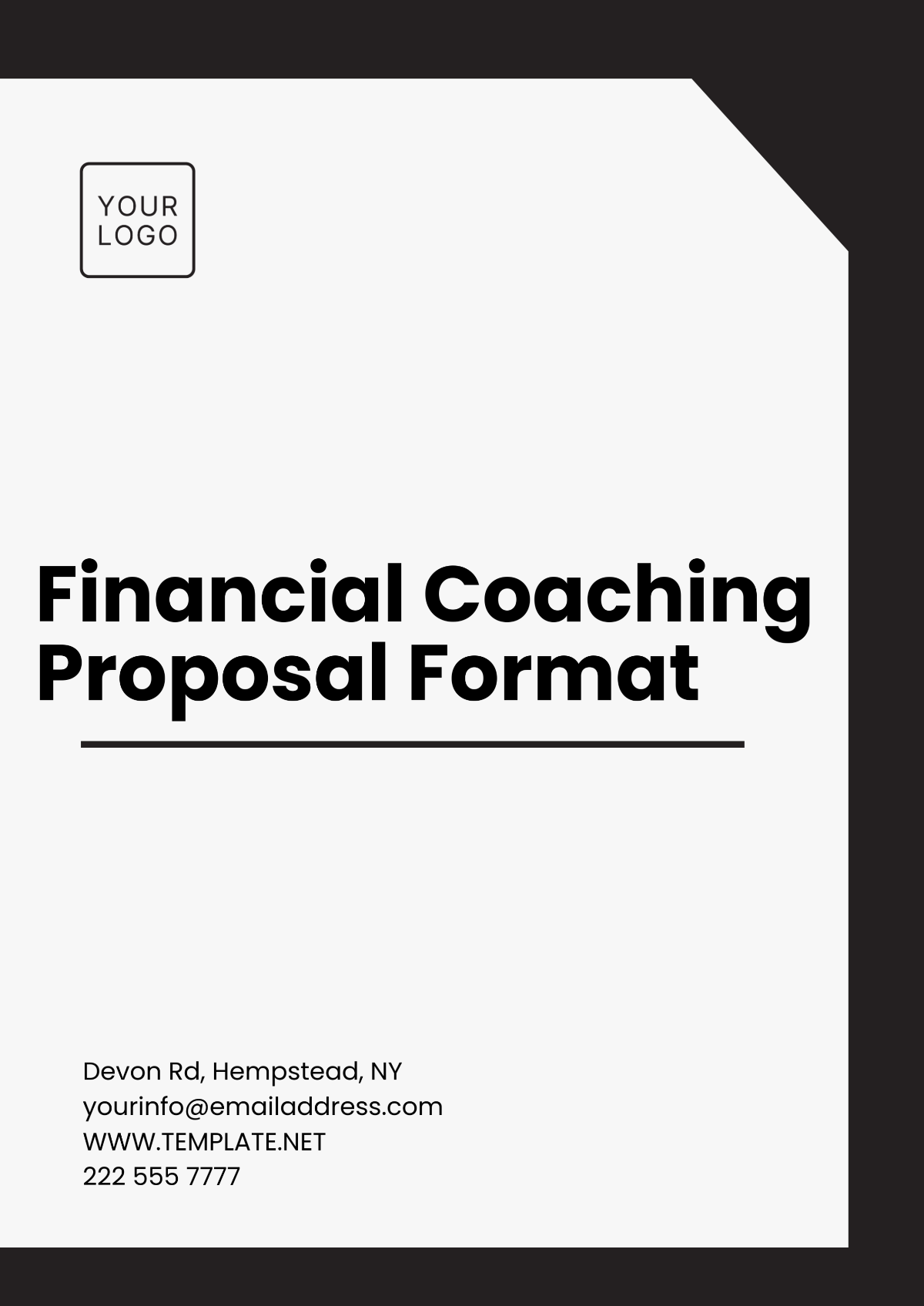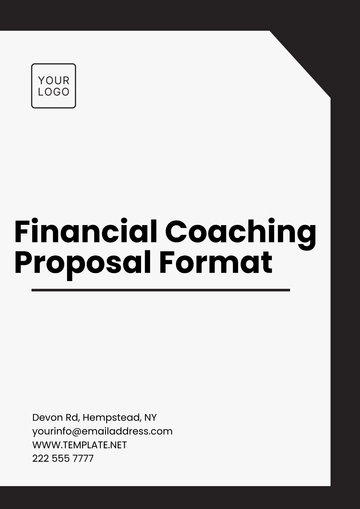Free Financial Coaching Proposal Format

Client’s Name: [Client's Name]
Date: [Date]
Prepared by: [Your Name]
I. Executive Summary
Provide a brief overview of the proposal, summarizing the purpose of the financial coaching, the benefits, and the value it brings to the client. Mention how this coaching will address specific financial challenges and help achieve long-term financial stability and growth.
II. Introduction
Outline the background and purpose of the proposal, including:
The current financial situation or common challenges clients face.
How financial coaching can be a tool to improve financial literacy, reduce debt, increase savings, or plan for major life goals.
III. Objectives
Clearly state the main objectives of the coaching program. Examples may include:
Develop and implement a personalized financial plan.
Improve financial decision-making skills.
Increase savings and investments.
Achieve specific financial goals (e.g., debt reduction, home purchase, retirement planning).
IV. Scope of Services
Provide a detailed list of the services included in the coaching program:
Financial Assessment: Comprehensive review of income, expenses, assets, and liabilities.
Goal Setting: Establish short-term and long-term financial goals.
Budget Planning: Develop a monthly budget tailored to the client's lifestyle and goals.
Debt Management: Strategies to reduce and manage debt efficiently.
Investment Planning: guidance on starting or optimizing investment portfolios.
Retirement and Estate Planning: Long-term strategies for financial security and legacy planning.
Regular Check-ins and Progress Tracking: Monthly or quarterly meetings to monitor progress and adjust plans.
V. Coaching Methodology
Explain the methodology used in coaching sessions, which may include:
One-on-One Coaching Sessions: Scheduled meetings (in person or online) to address financial topics and check progress.
Customized Financial Worksheets and Tools: Personalized tools to help track budgets, spending, and financial growth.
Educational Resources: Access to webinars, e-books, and articles on financial management topics.
VI. Timeline
Provide an estimated timeline for the coaching program, including the frequency of sessions and a tentative start and end date. An example could be:
Week 1: Initial assessment and goal setting.
Week 2-4: Budgeting and debt management.
Month 2-3: Investment planning.
Month 4 and beyond: Ongoing check-ins and adjustments.
VII. Deliverables
List the tangible outcomes the client will receive at the end of the coaching program, such as:
A personalized financial plan.
Budget and savings tracking sheets.
Debt reduction plan.
Investment portfolio strategy (if applicable).
VIII. Fees and Payment Terms
Outline the fees for the financial coaching services, including:
Pricing model (e.g., hourly rate, monthly rate, or flat fee for the program).
Payment schedule (upfront, installments, or at specific milestones).
Any additional costs (e.g., for educational resources or additional sessions).
- 100% Customizable, free editor
- Access 1 Million+ Templates, photo’s & graphics
- Download or share as a template
- Click and replace photos, graphics, text, backgrounds
- Resize, crop, AI write & more
- Access advanced editor
The Financial Coaching Proposal Format Template offered by Template.net is a fully customizable and downloadable solution designed to help you craft professional financial coaching proposals. This printable template allows you to quickly create tailored proposals that meet your clients' needs. It is editable in our AI Editor Tool, providing flexibility to adjust content effortlessly.
You may also like
- Business Proposal
- Research Proposal
- Proposal Request
- Project Proposal
- Grant Proposal
- Photography Proposal
- Job Proposal
- Budget Proposal
- Marketing Proposal
- Branding Proposal
- Advertising Proposal
- Sales Proposal
- Startup Proposal
- Event Proposal
- Creative Proposal
- Restaurant Proposal
- Blank Proposal
- One Page Proposal
- Proposal Report
- IT Proposal
- Non Profit Proposal
- Training Proposal
- Construction Proposal
- School Proposal
- Cleaning Proposal
- Contract Proposal
- HR Proposal
- Travel Agency Proposal
- Small Business Proposal
- Investment Proposal
- Bid Proposal
- Retail Business Proposal
- Sponsorship Proposal
- Academic Proposal
- Partnership Proposal
- Work Proposal
- Agency Proposal
- University Proposal
- Accounting Proposal
- Real Estate Proposal
- Hotel Proposal
- Product Proposal
- Advertising Agency Proposal
- Development Proposal
- Loan Proposal
- Website Proposal
- Nursing Home Proposal
- Financial Proposal
- Salon Proposal
- Freelancer Proposal
- Funding Proposal
- Work from Home Proposal
- Company Proposal
- Consulting Proposal
- Educational Proposal
- Construction Bid Proposal
- Interior Design Proposal
- New Product Proposal
- Sports Proposal
- Corporate Proposal
- Food Proposal
- Property Proposal
- Maintenance Proposal
- Purchase Proposal
- Rental Proposal
- Recruitment Proposal
- Social Media Proposal
- Travel Proposal
- Trip Proposal
- Software Proposal
- Conference Proposal
- Graphic Design Proposal
- Law Firm Proposal
- Medical Proposal
- Music Proposal
- Pricing Proposal
- SEO Proposal
- Strategy Proposal
- Technical Proposal
- Coaching Proposal
- Ecommerce Proposal
- Fundraising Proposal
- Landscaping Proposal
- Charity Proposal
- Contractor Proposal
- Exhibition Proposal
- Art Proposal
- Mobile Proposal
- Equipment Proposal
- Student Proposal
- Engineering Proposal
- Business Proposal



























